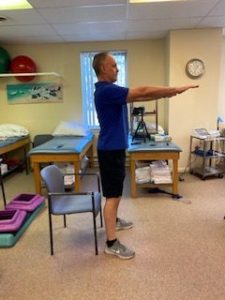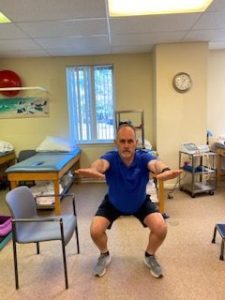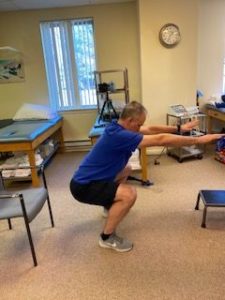
The dreaded squat is maligned in the public as a sure fire way to hurt your back or knees. Even doctors will tell patients, “Don’t squat!” No bearing on recent evidence. The reality is most people can do a basic squat if taught a few pointers and learn to slowly become more adept at this exercise.
For the record, I don’t mean to create an image of a Crossfitter or powerlifter, jacking up 5 plates on each side! If that is your goal, you are reading the wrong article and clearly know the benefits of squatting. I’m talking about a bodyweight squat, also known as “getting out of a chair.” (That’s sarcasm, Sheldon.)
Every day, we are required to get low to the ground for a variety of activities: picking up our grandkids, getting laundry out of the dryer, gardening, or getting up from a really low couch after a 3 hour Netflix binge. Why don’t we practice this movement so we don’t injure ourselves when performing these simple, everyday movements?
Enough said – here we go!
Step 1:
- Place a chair behind you and place your hands in front of you in line with your shoulder height. (Often referred to as a “Zombie Squat”.)
- Stand with your heels about the width of your hips.
- Your feet should be slightly turned out at about 30 degrees, toeing out from straight ahead.
- During all movements, place knees in line with hips.
- Hands forward and eyes on the horizon.
- Visualize your foot as a tripod at the bottom of your foot. One point of the tripod at the ball of your big toe, 2nd one by your outside toe and lastly, one at your heel. Apply even pressure through all 3 points of the tripod. (Horschig, Aaron. The Squat Bible: The Ultimate Guide to Mastering the Squat and Finding Your True Strength. April, 2017)
Step 2:
- Begin to lower your body, and as you do, your gaze should remain on the horizon.
- Chest is forward and a slight indent above your waistline.
- As you lower, you want to allow the knees to go forward and hips go backwards. (Often refer to this as sitting down on a toilet bowl.)
- Visualize a straight line over the middle of your foot and that is your balance point.
- As you descend, “push out your knees” to the side.
- Depending on your comfort, you may only be able to lower a few inches. As your body understands the movement and warms up, you can go lower.
Step 3:
- Once you get to a comfortable depth, pause and return to standing, pushing through your hips and allowing them to guide the movement.
Everyone’s anatomy is different, so the positioning at the start and movements may vary depending on the individual. For me, my upper body is proportionately longer than my lower body. For others, the upper thigh length may be different than the lower leg. So, when observing each other’s individual squat, it may vary in appearance.
When performing a high or low back or front squat, the positioning is different but the goal is to maintain your body over your base of support for the most efficient movement. As the weight increases, the breakdown in form will affect performance, but that is for another time. We are simply trying to get down low to reach a chair or pick up a reasonable amount of weight from a low to high or high to low position.





